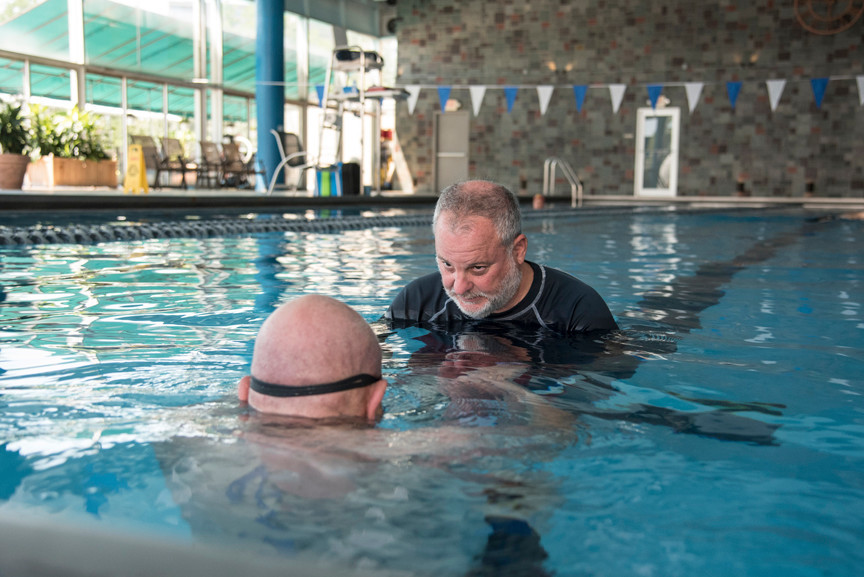Helping people to enjoy a splash
David Hochhauser has not gone for a swim in 58 years.
At age 12, Mr. Hochhauser watched a friend drown in a lake, a traumatic experience that left him with a crippling fear of water and swimming. But on July 20, he stood in a 4-foot pool at the Club of Riverdale and submerged himself for the first time since childhood.
“I want to be comfortable in the water—I don’t want to be an aquatic swimmer—I just want to be comfortable,” he said after his session. “It’s hot out, you want to be able to get in the pool and cool off.”
During the final minutes of Mr. Hochhauser’s first lesson, instructor and counselor Jeff Krieger coached him through dipping his head below the water and exhaling through his nose.
“See? That was the most relaxed you’ve been all day, because you were breathing out through your nose,” Mr. Krieger said as his client emerged from the pool with a smile.
Mr. Krieger says he is one of a half-dozen instructors in the world who teach people to deal with varying degrees of aquaphobia.
“Forty percent of adults suffer from sort of fear of water,” he said. “[Mr. Hochhauser] went through a traumatic experience – you know, watching someone drown and being helpless … and not being able to go in there and save him, and you’re a kid—even as an adult—that plays with your head.”
Mr. Krieger grew up in the water. He swam recreationally his entire life and even competed through college, but it wasn’t until he was working on a master’s degree in counseling that he discovered his sympathy for people with aquaphobia.
“I was getting all these children … It wasn’t just that they were having a bad day – I mean, every kid gets cranky, and they don’t want to get in the pool because it’s too cold or they’re having a bad day—these kids had a death-gripped fear of water,” he said. “They dug their fingernails so deep into my skin – with me holding then in literally a foot-and-a-half of water.”
When Mr. Krieger called the American Red Cross for information on water-related fears, they told him they didn’t have any. The organization offered to let him write a report on the issue, but Mr. Krieger wanted instead to implement treatment programs.
“What’s the point of identifying it if you can’t do anything with it,” he said. “They finally acknowledged: ‘Yes, there is a problem, yes, there is a need for a program.’ But like any big, disorganized organization, it takes time.”
Mr. Krieger has been offering his classes at The Center of Riverdale for a little over a month, but has been working at other locations in Riverdale for six years.
“I want to plant a flag here and say: ‘This is the center for people who have a phobia of water,’” he said. “I want to leave a program in place where other people can learn to do this, so that people all over the world can overcome their fear of water.”
Water phobias range, Mr. Krieger said, from cases as severe as Mr. Hochhauser, to adults who simply never learned to swim. He said the leading cause is usually a genetic predisposition for fear or paranoia.
“There’s about 3,000 people living in this building,” he said. “Statistically speaking, there’s probably 150-200 people with a fear of water.”
Mr. Krieger was also featured in a documentary called “Take the Plunge,” which follows him as he teaches two African-American women to overcome their fear of water.
“Of course I want as many customers as I can handle but I have a much bigger picture in mind,” he said. “The rate of water phobias and non-swimmers in black and Hispanic communities is ten times that of white communities, so that’s what the documentary is about.”






